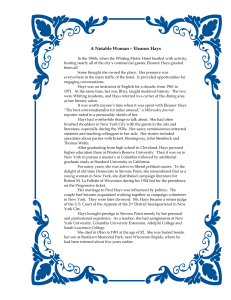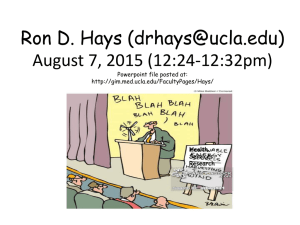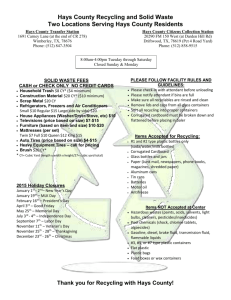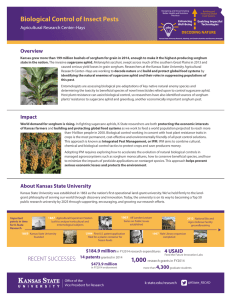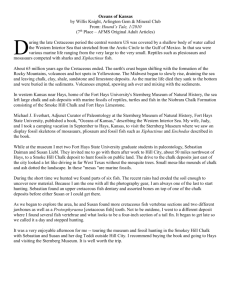FORT HAYS BRANCH STATION
advertisement
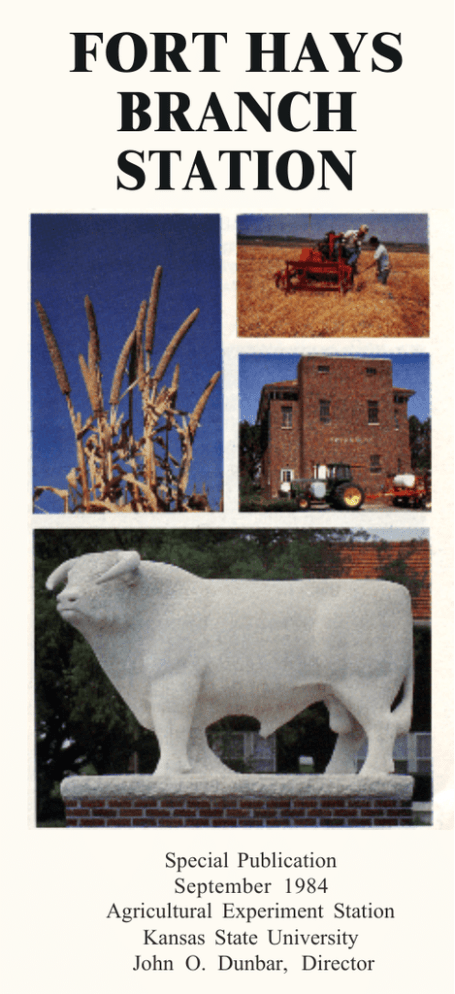
FORT HAYS BRANCH STATION Special Publication September 1984 Agricultural Experiment Station Kansas State University John O. Dunbar, Director Welcome to the Fort Hays Branch Experiment Station, the oldest and largest of five branches of the Kansas Agricultural Experiment Station (KAES). INFORMATION More information on the Hays Roundup, Field Days, or other aspects of the Station is available from the Fort Hays Branch Experiment Station, Fort Hays, Kansas 67601, or call 913-625-3425. The 1895 Kansas legislature declared that “The experience of the settlers upon the plains of western Kansas has demonstrated conclusively that agriculture cannot be pursued with profit under existing natural conditions.” The legislators saw the need for conducting research where it would be applied. So, in 1901, on land once part of Fort Hays Military Reservation, the Station was established with a mission to conduct basic and applied research appropriate to western Kansas where rainfall is limited. The Fort Hays Military Reservation was established to provide protection against hostile Indians for railroad construction crews and settlers. The nearby city of Hays became increasingly important to Kansans when the railroad reached it in October 1867. A scenic, tree-lined drive leads visitors to Station headquarters. In 1901, the only trees were along a creek, but now thousands of trees and shrubs have been planted on the grounds. The Station owns or leases more than 3,700 acres. Several brick buildings dot the landscape, including the office, auditorium, crops laboratory, automotive and machine shop, and seed house, which is used for storage of foundation-quality seed. The Station has a building for processing crops harvested from experiment fields. There are 12 greenhouses, a laboratory, and head-house, which includes seven growth chambers used by plant breeders. Inside the head-house is also a sophisticated plant pathology laboratory. Several machine sheds, feed barns, and a feed mill equipped to formulate a large variety of feedstuffs are located on the Station grounds. A large covered arena is used for Station field days and other events. The Fort Hays Branch Experiment Station is located just southwest of Hays (see map). With two hospitals, the city is a center for medical treatment, serving most of northwest Kansas. Hays also is home to Fort Hays State College (enrollment 5,000). Hays, with a population of 16,300, is 160 miles west of Manhattan and 172 miles northwest of Wichita. The city can be reached by bus and is easily accessible via U.S. Highway 183, state Route 274, and Interstate 70. Research at the Fort Hays Branch Station, like that at all five branch experiment stations and 11 experiment fields, is an integral part of the KAES at Kansas State University in Manhattan. Projects at the branch stations are closely related to those conducted at the main station on campus. Branch Station research concentrates on agricultural needs in specific parts of the state. For example, problems of west central Kansas are the focus at Fort Hays. In many cases, research results apply to a much broader area, sometimes worldwide. Results of the research are presented at scientific meetings and field days and released through KAES publications. Agricultural production in this region centers around wheat, sorghum, and beef cattle, and much ot the research conducted at Fort Hays relates to these commodities. But the needs of consumers and the worldwide marketplace may change, so the nine scientists presently assigned to Fort Hays also have research programs in such alternative crops as pearl millet, sunflowers, and triticale. Several wheat varieties currently planted in Kansas were developed at the Fort Hays Branch Experiment Station. These include Eagle, Sage, Cheney, Larned, and Arkan. Wheat breeding efforts concentrate on developing high-yielding, high-quality varieties that have short strong straw; good emergence characteristics; and resistance to wheat streak mosaic virus, soilborne mosaic virus, Hessian fly, Cephalosporium leaf stripe, leaf rust, stem rust, powdery mildew, and other production hazards. Examples of wheat diseases and their economic impact: Wheat Streak Mosaic Virus results in $32 million damage to the wheat crop each year. Scientists have identified sources of resistance, but it has proven difficult to incorporate that resistance into high-quality, high-yielding wheats. Basic research holds promise for solving this major disease problem. Soilborne Mosaic Virus causes Kansas wheat growers to lose more than $30 million each year. Wheat breeders have incorporated resistance to this disease into highly productive varieties. Tan Spot, Take-all, Cephalosporium Stripe, and Rusts combine to cause an annual loss of more than $45 million to Kansas farmers. Scientists at the Fort Hays Station are looking for lines resistant to these diseases that can be used in the wheat improvement program. The goal of the sorghum breeding program is to develop improved varieties of grain and forage sorghum with increased yield and multiple insect and disease resistance. As part of that program, researchers also hope to develop improved procedures to identify insect and disease resistance. Maize Dwarf Mosaic Virus claims two percent of the sorghum crop each year, or about three million bushels. Scientists have identified resistant strains and are working to incorporate resistance into inbred lines that can be used in developing resistant hybrids. Bacterial Stripe and Bacterial Streak: These costly diseases damage from one to one and a half percent of the sorghum crop each year. Fairly similar, they destroy leaf tissue and reduce yields under severe conditions. Current research centers on developing a greenhouse screening test to evaluate the breeding lines used at Hays for resistance to both diseases. The soil management research program includes determining fertilizer requirements for wheat, grain sorghum, sunflowers, pearl millet, and oats. Another goal is to compare high populations of plants, late planting, and narrow rows with the conventional management procedures for grain sorghum production. Other aspects of the research include studying the effects of reduced tillage and comparing crop rotations under conventional and reduced-tillage systems. Scientists also study efficiency of water use by crops and how it affects management practices. Commercially available and experimental herbicides are compared for safety and effectiveness in field studies at Hays on wheat, grain sorghum, sunflowers, and in fallow. Results are combined with those of researchers from other parts of Kansas and from adjoining states to make extension recommendations to farmers. The goals of the program include developing more effective and efficient weed control techniques in conventional, reduced-, and no-tillage production systems and studying factors affecting herbicide performance. Studies to determine the nutritional value of various feeds are part of an extensive cattle nutrition program aimed at providing the most nutrition at the least cost. Nutrition work includes evaluating feed supplements and implants. Researchers in cattle production participate in several areas of cooperative research. In sorghum breeding, for example, there has been a substantial effort to relate agronomic characteristics of forage sorghums to feed value after ensiling. Present efforts focus on precisely measuring the nutritional value of sorghum grain. Extensive studies also are conducted to compare feeding value of wheat types. Other studies are in progress to determine the nutritional value of millet for beef cattle. Hays scientists are studying the effects on carcass quality of breeding, management, and nutrition of intact males. The goal of this research on calf implant response, protein nutrition, and market meat quality is to develop a feasible slaughter-bull program. The scientists hope to modify bull carcass composition by nutrition and management. In range management, the emphasis is on evaluation of stocking rate schemes to increase production per acre without damage to the range. Grazing management studies center on determining procedures to optimize beef cattle production on native and re-established ranges. The research includes studies of fertilization, pesticide, and burning practices to improve range forage quantity and quality; feed supplements to enhance beef animal performance on range forages; and insect pest control procedures to improve beef animal gains from grazing. Roundup. Each April the Fort Hays Branch Experiment Station hosts the Hays Roundup to report recent findings from Station beef cattle investigations. Cattle producers gather in the arena for a firsthand look at groups of cattle while Station scientists explain research findings. This visual inspection supplements the Roundup publication released for the day. Judging School and Contest. On the day following Roundup, the Station hosts a judging school and contest for 4-H and Vocational Agriculture Youth. The two divisions of the event, livestock and home economics, together attract 600 to 800 young people each year. Field Days. In June and August, the Station hosts Field Days to report on agronomic and plant pathology research. Visitors to the Station are transported to the fields for a close up look at the crops under discussion. Here they can see the results of various management practices and decide for themselves whether a new technique might be useful to them. * Developed and released to plant breeders sorghum lines resistant to sorghum greenbug and to maize dwarf mosaic virus. *Pioneered reduced tillage research in the Great Plains. Programs initiated here have been modified and adapted for use on several million crop acres. * From 1973 through 1983, millions of acres of Kansas land were planted to wheat varieties developed at the Station. * Conducted range research that resulted in recommendations that, if followed, could increase return from rangeland by more than 100 percent. *Developed programs using feed additives, growth stimulants, and processing methods that increased feed efficiency in beef cattle. *Studied non-traditional crops and their production methods in an attempt to broaden the crop choices available to farmers. Sunflowers are being planted on several thousands of acres and pearl millet shows promise as another alternative crop. Produced by the Editorial Office of the Kansas Agricultural Experiment Station: Steve Morgan, Editor; Eileen Schofield, Associate Editor; Cheryl May, Assistant Editor; Fred Anderson, Graphics Artist. Contribution 85-6-S Agricultural Experiment Station, Manhattan 66506 Special Publication Sept. 1984 Publications and public meetings by the Kansas Agricultural Experiment Station are available and open to the public regardless of race, color, national origin, sex, or religion.
